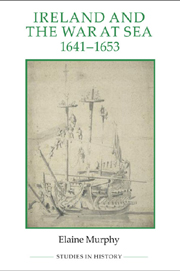Book contents
- Frontmatter
- Contents
- List of figures, maps and tables
- Acknowledgements
- Abbreviations
- Glossary
- Map 1 Ireland, 1641–9: principal ports and locations
- Map 2 The British Isles, 1641–9: principal ports and locations
- Map 3 The British Isles and Europe, 1641–9: principal ports and locations
- Introduction
- PART I The War at Sea, 1651–1653
- 1 The outbreak and spread of the rebellion, October 1641–September 1643
- 2 ‘Weathering the storm’, September 1643–July 1646
- 3 ‘Infested with pirates’, August 1646–August 1649
- 4 The support of the navy, September 1649–April 1653
- Part II Navies and the Conduct of the War at Sea
- Appendices
- Bibliography
- General index
- Index of ships
2 - ‘Weathering the storm’, September 1643–July 1646
from PART I - The War at Sea, 1651–1653
Published online by Cambridge University Press: 05 April 2013
- Frontmatter
- Contents
- List of figures, maps and tables
- Acknowledgements
- Abbreviations
- Glossary
- Map 1 Ireland, 1641–9: principal ports and locations
- Map 2 The British Isles, 1641–9: principal ports and locations
- Map 3 The British Isles and Europe, 1641–9: principal ports and locations
- Introduction
- PART I The War at Sea, 1651–1653
- 1 The outbreak and spread of the rebellion, October 1641–September 1643
- 2 ‘Weathering the storm’, September 1643–July 1646
- 3 ‘Infested with pirates’, August 1646–August 1649
- 4 The support of the navy, September 1649–April 1653
- Part II Navies and the Conduct of the War at Sea
- Appendices
- Bibliography
- General index
- Index of ships
Summary
‘The dangers facing the parliamentary navy in 1643 were real and pressing. In the event it weathered the storm.’
The Cessation of 1643 offered a number of immediate maritime benefits to the confederates and royalists in Ireland, allowing them to concentrate their military and naval war efforts against the parliamentarians in Ireland and elsewhere in the Three Kingdoms. The parliamentarian cause in Ireland thus in the short term suffered from the brokering of a truce. In particular the loss of access to ports put parliamentary naval forces on the back foot in the Irish Sea. In the following three years, much of the fighting that took place in the seas around Ireland or at outposts along the coast stemmed from the Cessation. The parliamentary navy could not prevent the transport of soldiers from Ireland to aid the king in England nor the surrender of Duncannon fort and Bunratty castle to the confederates in 1645 and 1646. In the longer term, however, many of the gains made by the royalists and confederates proved to be illusory as the parliamentary navy did enough to weather the storm.
September 1643–July 1644
The greatest gain to the confederate maritime cause from the Cessation came from the adherence of Duncannon fort and its governor Lord Esmond. Parliamentary men-of-war could no longer safely anchor below the fort and stop shipping from going to and from Waterford and New Ross. Port books from Waterford in this period suggest that a large volume of ships traded with the town from a range of foreign ports.
- Type
- Chapter
- Information
- Ireland and the War at Sea, 1641–1653 , pp. 35 - 52Publisher: Boydell & BrewerPrint publication year: 2012



